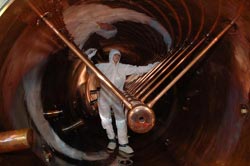New superheavy elements can be uniquely identified

photo: G. Otto, GSI Helmholtz Center for Heavy Ion Research <br><br>GSI linear accelerator <br>
An international team of researchers presents fresh evidence that confirms the existence of the superheavy chemical element 115. The experiment was conducted at the GSI Helmholtz Center for Heavy Ion Research, an accelerator laboratory located in Darmstadt.
Under the lead of physicists from Lund University in Sweden, the group, which included researchers from Johannes Gutenberg University Mainz (JGU) and the Helmholtz Institute Mainz (HIM), was able to present a way to directly identify new superheavy elements. Elements beyond atomic number 104 are referred to as superheavy elements. They are produced at accelerator laboratories and generally decay after a short time. Initial reports about the discovery of an element with atomic number 115 were released from a research center in Russia in 2004. The then presented indirect evidence for the new element, however, was insufficient for an official discovery.
For the new experiment, scientists at the Institute of Nuclear Chemistry at Mainz University took a sample of the exotic element americium. They deposited an americium layer on a thin foil, which was subsequently bombarded with calcium ions at the GSI facility. For the first time, the exploitation of a new detector system allowed registering photons along with the alpha-decay of the new element and its daughter products. Measured photon energies correspond to those expected for X-rays from these products and thus serve as the element's fingerprint.
“This can be regarded as one of the most important experiments in the field in recent years, because at last it is clear that even the heaviest elements' fingerprints can be taken”, agreed Professor Dirk Rudolph from Lund University in Sweden and Professor Christoph Düllmann, professor at Mainz University and leading scientist at GSI Darmstadt and HIM. “The result gives high confidence to previous reports. It also lays the basis for future measurements of this kind.”
The element 115 is yet to be named: a committee comprising members of the international unions of pure and applied physics and chemistry will review the new findings and decide whether further experiments are needed to acknowledge the discovery of the element. Only after such final acceptance, a name may be proposed by the discoverers.
Besides the X-ray events, the researchers have also obtained data giving them a deeper insight into the structure and properties of the heaviest currently known atomic nuclei. This paves the way towards improved predictions for properties of nuclei beyond the border of current knowledge.
The new findings will soon be presented in the scientific journal The Physical Review Letters.
Media Contact
More Information:
http://www.uni-mainz.deAll latest news from the category: Physics and Astronomy
This area deals with the fundamental laws and building blocks of nature and how they interact, the properties and the behavior of matter, and research into space and time and their structures.
innovations-report provides in-depth reports and articles on subjects such as astrophysics, laser technologies, nuclear, quantum, particle and solid-state physics, nanotechnologies, planetary research and findings (Mars, Venus) and developments related to the Hubble Telescope.
Newest articles

Recovering phosphorus from sewage sludge ash
Chemical and heat treatment of sewage sludge can recover phosphorus in a process that could help address the problem of diminishing supplies of phosphorus ores. Valuable supplies of phosphorus could…

Efficient, sustainable and cost-effective hybrid energy storage system for modern power grids
EU project HyFlow: Over three years of research, the consortium of the EU project HyFlow has successfully developed a highly efficient, sustainable, and cost-effective hybrid energy storage system (HESS) that…

After 25 years, researchers uncover genetic cause of rare neurological disease
Some families call it a trial of faith. Others just call it a curse. The progressive neurological disease known as spinocerebellar ataxia 4 (SCA4) is a rare condition, but its…





















